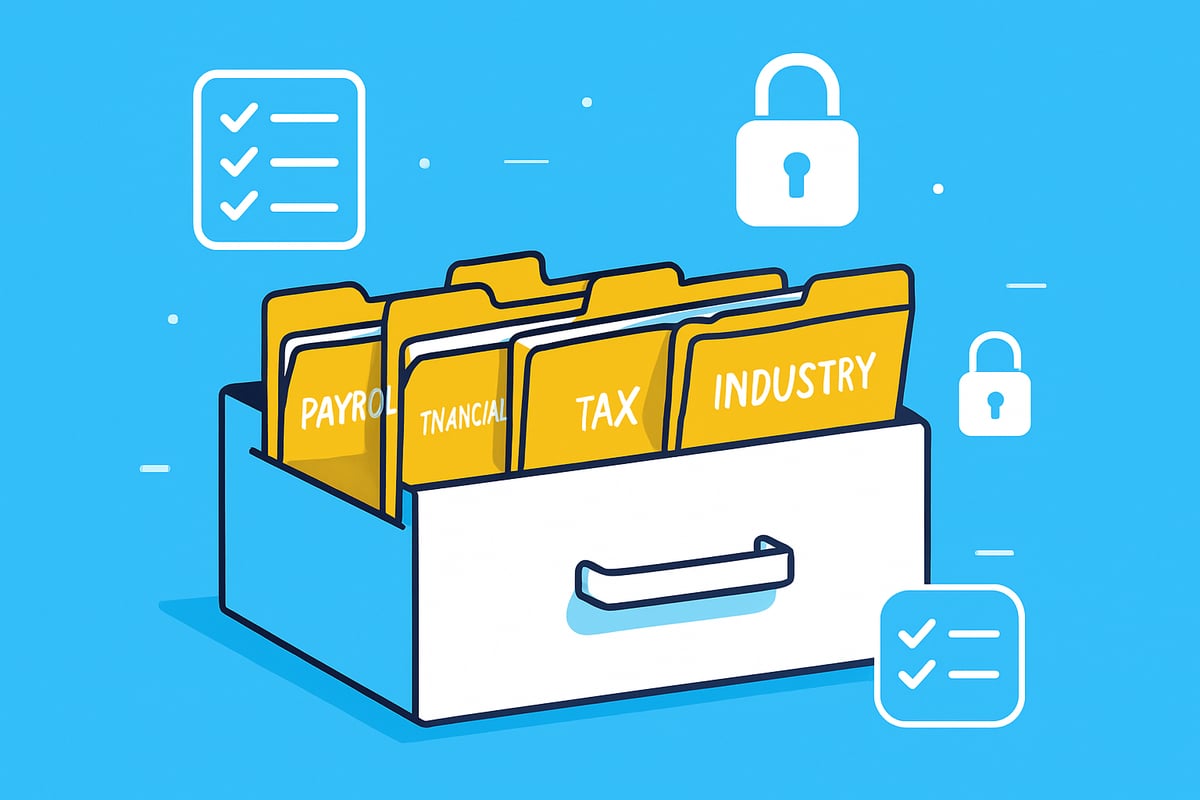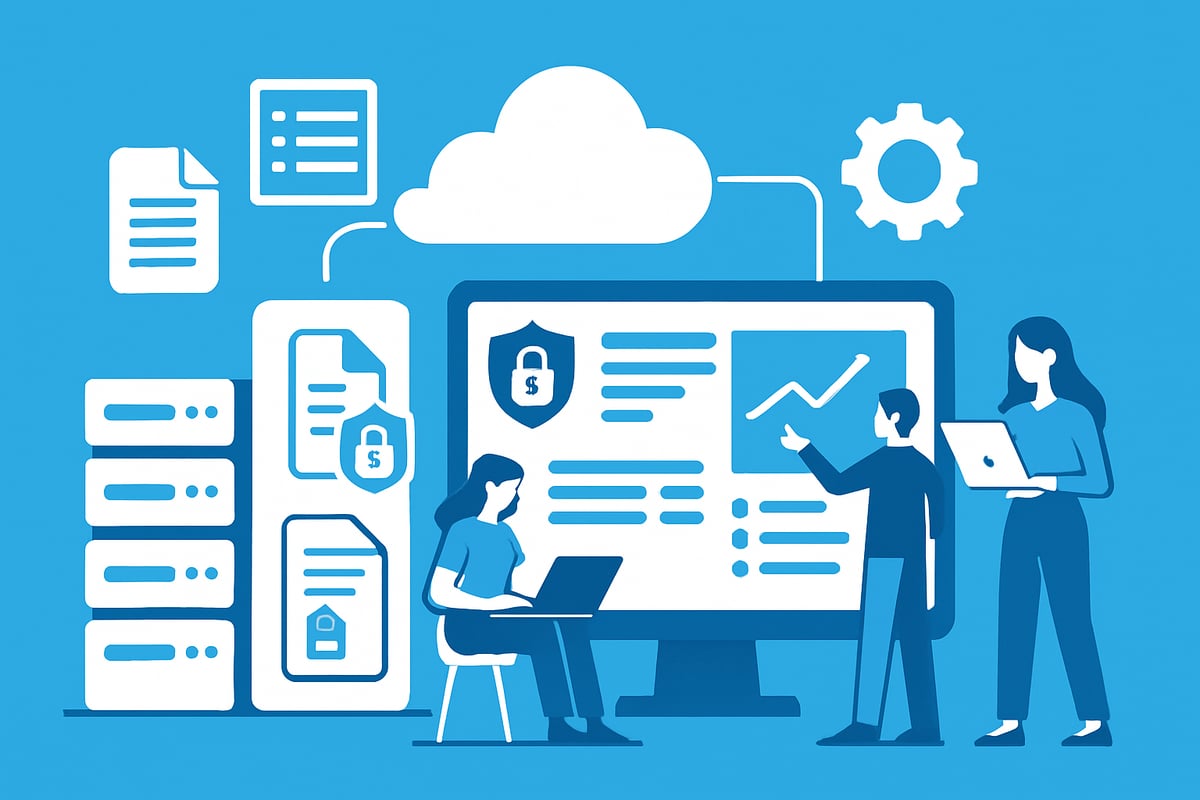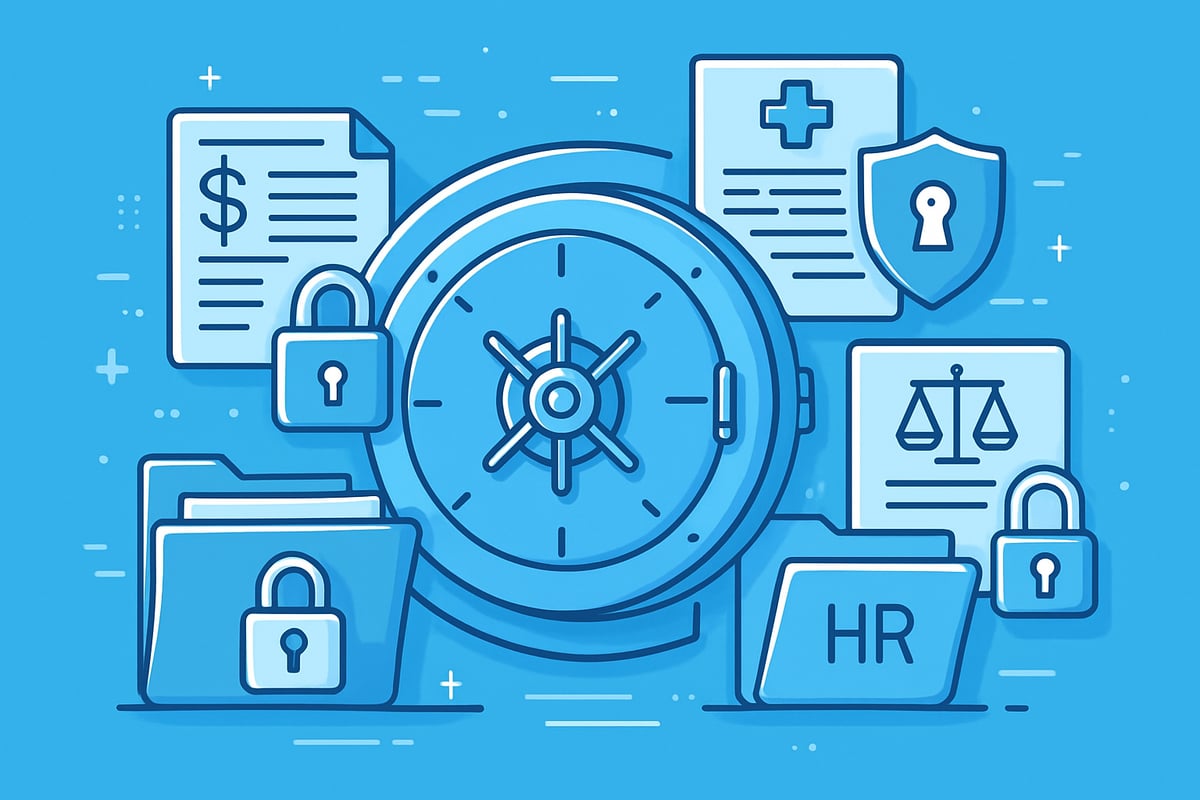Are your digital files scattered, compliance worries mounting, or records slipping through the cracks? In 2025, digital record keeping is not just a convenience—it is the backbone of secure, efficient, and resilient business operations.
With regulations tightening, cyber threats rising, and remote work now standard, mastering digital record keeping is essential for every organization. This guide breaks down the latest best practices, tools, and strategies to keep your business organized, compliant, and audit-ready.
Read on for step-by-step advice, expert insights, and future-proof solutions for digital record keeping in 2025. Stay ahead, stay secure, and build a system that lasts.
Understanding Digital Record Keeping in 2025
Digital record keeping is transforming how organizations manage, store, and retrieve information. In 2025, the shift from traditional paper-based systems to digital solutions is more than a trend—it is becoming an industry standard. With remote work on the rise and regulations tightening, businesses of all sizes must rethink their record management strategies.

What Is Digital Record Keeping?
Digital record keeping refers to the systematic process of organizing, storing, retrieving, and disposing of records electronically. Unlike traditional paper files, digital records are managed using computers, cloud storage, and specialized software. This approach covers a wide range of information, from employee documents and financial statements to contracts and email communications.
The main difference between digital and paper-based record keeping lies in accessibility and efficiency. Digital records can be searched, sorted, and shared with a few clicks. Paper files, on the other hand, are prone to loss, misfiling, and physical damage.
Types of digital records include:
- Financial documents: invoices, receipts, expense reports
- HR records: pay stubs, contracts, performance reviews
- Legal files: contracts, compliance certificates, licenses
- Communications: emails, memos, correspondence
- Project files: proposals, plans, deliverables
The surge in remote work and the widespread adoption of cloud technology have accelerated this shift. In fact, 85% of businesses now use digital tools for record management, reflecting a clear industry movement toward digital record keeping.
Why Digital Record Keeping Matters More Than Ever
The importance of digital record keeping has never been greater. Regulatory compliance is a major driver, with laws like GDPR, HIPAA, and IRS requirements shaping how records must be stored and protected. Failing to comply can lead to hefty fines, audits, or legal action.
Business continuity is another critical factor. Digital records offer resilience against disasters, cyberattacks, and hardware failures. Unlike paper files, digital backups can be restored quickly, reducing downtime and protecting vital information.
Operational efficiency is a major benefit. Teams can access records instantly, collaborate from anywhere, and reduce the costs associated with physical storage. Security is also enhanced. Modern digital systems use encryption, access controls, and detailed audit trails to protect sensitive data.
Consider this: organizations that switch to digital record keeping reduce their audit preparation time by up to 50%. This means less stress, fewer errors, and a smoother workflow overall.
Key Trends Shaping 2025
Several trends are shaping the future of digital record keeping as we head into 2025. Artificial intelligence is playing a key role, with AI-powered document management systems automating classification and metadata tagging. This reduces manual work and improves accuracy.
Cloud-based solutions are quickly overtaking on-premises storage. Businesses are choosing cloud platforms for their scalability, security, and real-time collaboration features. Integration is another significant trend. HR, payroll, and document management platforms now work together seamlessly, streamlining workflows across departments.
Data privacy and user access control are gaining attention. With stricter regulations and rising cyber threats, organizations are prioritizing privacy and limiting access based on roles. For a deeper dive into these emerging trends and how they affect your strategy, check out the Top 10 Records Management Trends in 2025.
Staying ahead of these trends ensures your digital record keeping system remains secure, efficient, and compliant as technology and regulations evolve.
Essential Documents and Compliance Requirements
Keeping your organization compliant and audit-ready in 2025 begins with understanding which documents matter most. Digital record keeping is not just about scanning files, it is about knowing what to keep, for how long, and how to access them on demand.

Core Types of Records to Maintain
A robust digital record keeping system starts with identifying which documents are essential for your business. Every organization should preserve a core set of records, including:
- Payroll and Employment: Pay stubs, W-2s, 1099s, timecards, employment contracts, and performance reviews.
- Financial: Invoices, receipts, bank statements, and accounting ledgers.
- Tax and Regulatory: Tax returns, business licenses, permits, and compliance certificates.
- Contracts and Agreements: Client contracts, vendor SLAs, partnership agreements.
- Industry-Specific Records: Healthcare records for clinics, legal files for law firms, or project documentation for construction companies.
For a more detailed breakdown, check out this guide on essential documents for families, which can be adapted for business use as well.
As digital record keeping evolves, it is important to regularly review and update your list of essential documents. This ensures you are prepared for audits, legal inquiries, or sudden business needs. Remember, missing just one critical document can lead to compliance risks or operational setbacks.
Legal and Regulatory Obligations
Legal compliance is at the heart of digital record keeping in 2025. Various regulations dictate which records you must retain and for how long. Here is a quick overview of some of the most common requirements:
| Document Type | Regulatory Body | Minimum Retention Period |
|---|---|---|
| Tax Records | IRS | 3–7 years |
| Payroll Records | DOL | 3 years |
| Medical Records | HIPAA | 6 years |
| Financial Records | SEC/IRS | 7 years |
| Employee Records | EEOC | 1–3 years |
Failing to follow these guidelines can result in fines, legal action, or failed audits. For example, the IRS requires businesses to retain tax returns and supporting documents for up to seven years in some cases. The Department of Labor mandates that payroll records be kept for at least three years.
Digital record keeping makes it easier to meet these requirements by automating retention schedules and providing secure, searchable storage. However, laws can vary by state and industry, so always tailor your practices to your specific sector.
Best Practices for Document Retention and Organization
To maximize the benefits of digital record keeping, you need more than just storage. Here are some best practices:
- Create a Retention Schedule: Develop a document that lists each record type and its required retention period.
-
Systematic Labeling and Indexing: Use consistent naming conventions, such as
ClientName_Invoice_MonthYear.pdf, to ensure files are easy to find. - Avoid Premature Disposal: Only delete records once their retention period has expired and after confirming no ongoing legal or audit needs.
- Prevent Excessive Storage: Regularly review and dispose of outdated files to keep your system efficient.
- Secure Your Files: Implement access controls and audit trails to track who views or edits documents.
A well-organized digital record keeping system not only supports compliance but also saves time during audits and improves day-to-day efficiency. Building these habits now sets your business up for long-term success and minimizes the risk of costly errors.
Choosing and Implementing Digital Record Keeping Tools
Selecting the right tools for digital record keeping can feel overwhelming, but a structured approach makes the process manageable. In 2025, the right solution will not only help you stay compliant but also boost efficiency and security. Let’s explore how to evaluate, implement, and optimize these tools for your organization’s needs.

Evaluating Digital Record Keeping Solutions
Before committing to a platform, it’s wise to compare the most popular digital record keeping solutions side by side. Cloud-based services like Google Drive and Dropbox offer familiar interfaces, while specialized Document Management Systems (DMS) provide advanced categorization, search, and version control features. HR and payroll software can centralize employee records, payroll data, and compliance documents in one place.
Here’s a quick comparison table:
| Platform | Best For | Key Features |
|---|---|---|
| Google Drive | General use | Collaboration, sharing, cloud storage |
| Dropbox | File management | Sync, backup, integration options |
| DMS (e.g., M-Files, DocuWare) | Compliance, audit trails | Automated classification, retention policies |
| HR/Payroll Software | Employee records | Payroll, tax forms, compliance alerts |
When evaluating options, look for:
- Automated backups and disaster recovery
- Real-time collaboration and access controls
- Compliance alerts and audit trails
For actionable advice on setting up a system, check out these record management system tips to align your digital record keeping strategy with best practices.
Choosing a scalable, secure solution is the foundation for effective digital record keeping in 2025.
Integration and Automation
Seamless integration is crucial for modern digital record keeping. By connecting your DMS with accounting, HR, and project management platforms, you enable smooth data flows and reduce manual work. Automation can further streamline file classification, data entry, and document retention workflows.
Consider these integration and automation opportunities:
- Syncing HR software with your DMS to automatically store new hire documents
- Linking accounting systems to automatically archive invoices and receipts
- Using workflow automation tools to trigger compliance alerts and retention reminders
Automated processes help minimize human error and keep your digital record keeping system up to date with minimal effort. Start by mapping out your current workflows, then identify manual steps that could be automated. This approach frees your team to focus on higher-value tasks.
A well-integrated and automated digital record keeping system is key to keeping records accurate and accessible.
Security and Access Controls
Security is non-negotiable in digital record keeping. Look for solutions with built-in encryption, both for data at rest and in transit. Multi-factor authentication (MFA) adds another layer of protection by requiring users to verify their identity before accessing sensitive files.
Key security features to prioritize:
- Role-based access controls to restrict sensitive records
- Detailed audit trails to track who accessed or edited a document
- Regular automated backups and secure storage
Many platforms also allow you to set permission levels, so only authorized personnel can view or modify critical documents. Regular security audits and user training are essential for identifying vulnerabilities and maintaining compliance.
By prioritizing robust security measures, you can protect your digital record keeping system from data breaches and unauthorized access.
Real-World Examples
Practical examples highlight how digital record keeping tools drive real results. Consider a small business that adopted a cloud-based DMS and reduced its physical storage needs by 70 percent. The team now retrieves files in seconds, rather than searching through boxes or outdated folders.
An HR department automated compliance alerts for payroll deadlines, eliminating late filings and reducing the risk of penalties. Another company integrated its accounting software with a DMS, ensuring all invoices are automatically archived and easy to retrieve during audits.
These real-world wins show that investing in digital record keeping tools leads to faster access, better organization, and improved compliance. When you combine the right technology with smart processes, your business is well prepared for the demands of 2025.
Data Security and Privacy in Digital Record Keeping
In 2025, data security and privacy are at the heart of digital record keeping. With sensitive information stored electronically, businesses face new risks and responsibilities. Let’s break down how to identify, protect, and manage your digital records securely.

Identifying Sensitive Data
Not all records are created equal. Some contain highly sensitive information that, if exposed, can lead to identity theft, financial loss, or regulatory penalties. In digital record keeping, sensitive data includes:
- Personal information (names, addresses, Social Security numbers)
- Financial records (bank statements, credit card details)
- Medical files (health history, insurance information)
- Legal documents (contracts, court filings)
Digital storage comes with risks. Unauthorized access, accidental deletion, and cyberattacks are growing concerns. According to Records Management Risks in 2025 and Beyond, data breaches are on the rise, highlighting the need for strong digital record keeping practices.
Regularly review the types of records you store. Identify which files require extra protection. This foundational step shapes every other security decision you make.
Implementing Security Measures
Protecting your digital record keeping system starts with robust security strategies. Here are essential measures to put in place:
- Encryption: Encrypt all data at rest and in transit, making files unreadable without proper authorization.
- Multi-factor authentication (MFA): Require users to verify their identity using two or more methods.
- Regular security audits: Schedule periodic checks to spot vulnerabilities in your storage systems.
- User training: Teach employees how to handle digital records securely and recognize potential threats.
A security self-assessment checklist can help you monitor compliance and spot weaknesses before they become problems. By embedding these measures into your digital record keeping workflow, you greatly reduce the risk of accidental exposure or attack.
Compliance with Privacy Laws
Legal compliance is a non-negotiable aspect of digital record keeping. Regulations like HIPAA (for healthcare), GLBA (for financial services), and GDPR (for international operations) set strict standards for how sensitive data is stored and accessed.
To stay compliant, follow these steps:
- Update your policies regularly to reflect new laws.
- Document all data handling procedures clearly.
- Maintain access logs for every file.
- Prepare for regular audits by keeping records organized and accessible.
Non-compliance can result in hefty fines and damage to your reputation. Make compliance a routine part of your digital record keeping system, not just a box to check during audits.
Building a Culture of Security
Security is not just about technology—it’s about people. Build a culture where everyone understands their role in protecting digital record keeping systems.
- Role-based access: Limit file access to only those who need it for their job.
- Ongoing education: Offer regular training sessions on privacy, security, and digital hygiene.
- Incident response planning: Develop clear protocols for responding to breaches or data loss.
By making digital record keeping security a shared responsibility, you create an environment where vigilance is second nature. When employees are empowered and informed, your organization is better prepared to handle evolving threats and maintain trust.
Steps to Achieve Audit-Ready Digital Record Keeping
Getting audit-ready is vital for any organization relying on digital record keeping. Audits can be stressful, but with clear processes, you can face them with confidence. By following the key steps below, you’ll make sure your digital record keeping is organized, compliant, and ready for any review.
Step 1: Organize and Label Records Consistently
Consistent organization is the backbone of audit-ready digital record keeping. Disorganized files can lead to wasted hours during audits and increase the risk of missing critical documents.
- Use clear naming conventions for every file, such as
VendorName_Invoice_2025-01.pdf. - Apply standardized tags or categories to group similar records.
- Keep a digital index or spreadsheet listing all essential documents.
A well-structured system not only saves time but also reduces stress when searching for important files. For more strategies on tackling file chaos, check out the stress of searching for important documents.
Step 2: Implement a Retention and Disposal Policy
A clear retention and disposal policy is crucial for effective digital record keeping. Keeping records longer than needed can clutter your system, while premature deletion risks compliance issues.
- Set retention periods for each document type, following IRS and DOL guidelines.
- Automate reminders for when records are due for review or disposal.
- Use secure deletion methods, such as digital shredding, to permanently remove sensitive files.
Here’s a simple example retention table:
| Document Type | Retention Period | Disposal Method |
|---|---|---|
| Tax Returns | 7 years | Secure delete |
| Payroll Files | 3 years | Digital shredding |
| Contracts | 6 years | Secure delete |
A policy like this keeps your digital record keeping compliant and clutter-free.
Step 3: Conduct Regular Internal Audits
Internal audits are your best defense against surprises during external reviews. They help you spot gaps, outdated files, or process flaws before auditors do.
- Schedule audits quarterly or biannually.
- Review a sample of records for accuracy, completeness, and policy compliance.
- Use mock audits to simulate real audit conditions and train your team.
Regular review of your digital record keeping processes builds confidence and ensures you’re always ready for the real thing.
Step 4: Prepare for External Audits
When an external audit looms, preparation is everything. Make sure your digital record keeping system can quickly produce any document, along with proof of compliance.
- Maintain detailed audit trails and access logs for all files.
- Store compliance certificates and supporting documents in accessible folders.
- Assign audit liaisons to coordinate document delivery and communication.
Referencing the Digital Preservation Strategy 2022-2026 can guide you in establishing long-term digital preservation practices, which are invaluable during audits.
Step 5: Continuous Improvement
Audit readiness is not a one-time achievement. Your digital record keeping practices should evolve as regulations, technology, and business needs change.
- Gather feedback after each audit to identify improvement areas.
- Update retention policies and tools regularly.
- Train staff on new compliance requirements and best practices.
Businesses that prioritize continuous improvement in digital record keeping report fewer audit issues and smoother operations overall.
Building a Robust Digital Record Keeping System for 2025 and Beyond
Building a robust digital record keeping system is essential for businesses aiming to thrive in 2025 and beyond. With evolving compliance demands and technological advances, a proactive approach ensures your records remain secure, accessible, and audit-ready. Let’s break down the core steps to future-proof your digital record keeping strategy.
Assessing Your Current Record Keeping Practices
Start by evaluating your existing digital record keeping setup. Inventory all digital and paper records across departments, including HR, finance, and legal. Identify gaps, redundancies, or outdated files that could pose risks.
Engage key stakeholders from IT, compliance, and operations to gather insights on current workflows and pain points. Ask questions like: Are critical documents easily retrievable? Are there bottlenecks in sharing or storing files? This step is foundational for a streamlined digital record keeping upgrade.
Create a checklist to track:
- Types of records held (financial, HR, legal, etc.)
- Storage locations (cloud, on-premises, physical)
- Access permissions and controls
- Compliance with retention policies
By understanding your starting point, you can set clear goals for your digital record keeping transformation.
Designing Your Digital Record Keeping Framework
With a clear assessment, design a framework tailored to your organization’s needs. Select digital record keeping tools that align with your business size, industry requirements, and compliance standards. Consider cloud-based document management systems for flexibility and security.
Map out workflows for document creation, approval, storage, and disposal. Assign roles and responsibilities to ensure accountability at every stage. Use systematic labeling, standardized file naming, and version control to boost consistency.
For more on the value of organized records, see The benefits of keeping your personal information organized. A well-designed digital record keeping system makes audits easier and enhances collaboration.
Training and Change Management
Introducing new digital record keeping tools requires thoughtful change management. Start with comprehensive onboarding sessions to familiarize employees with new platforms and protocols. Offer step-by-step guides and video tutorials for common tasks, such as uploading documents or setting access permissions.
Maintain open channels for feedback and address resistance by highlighting the benefits of improved digital record keeping—such as time savings and reduced compliance risks. Regular refresher trainings keep teams up to date on system updates and best practices.
Encourage a culture where everyone understands the importance of accurate, secure record management. This collective buy-in ensures your digital record keeping system is used to its full potential.
Monitoring, Maintenance, and Scaling
Ongoing monitoring is vital to keep your digital record keeping system effective. Schedule regular reviews to assess system performance, user engagement, and compliance with retention schedules. Use dashboards and reporting tools to identify trends or issues early.
Update software and security protocols as needed to address new threats or regulatory changes. As your business grows, ensure your digital record keeping solution can scale—add storage, integrate new tools, and adjust workflows for increased demand.
Create a maintenance calendar that includes:
- Software updates and security patches
- Review of access permissions
- Data backups and recovery tests
By staying proactive, you prevent small issues from becoming costly problems.
Future-Proofing Your Record Keeping Strategy
The digital record keeping landscape will continue to evolve. Stay informed about new regulations and emerging technologies. Invest in automation and AI-powered tools to streamline document classification, retention, and compliance monitoring.
For example, AI-driven systems can reduce manual filing time by 40 percent, freeing staff for higher-value work. Explore how financial controls are adapting with Modernizing Accounting Controls for 2025 Compliance Demands.
Build flexibility into your digital record keeping strategy so you can quickly adapt to changes. Regularly review policies, gather stakeholder feedback, and set aside resources for technology upgrades. By taking these steps, your organization will remain audit-ready and resilient well beyond 2025.
Now that you know how vital organized digital record keeping is for 2025, why not make things even easier for yourself and your family? Having all your essential information in one secure, accessible place saves time, reduces stress, and ensures you're always prepared—whether for tax season, emergencies, or just daily life. I recommend taking the next step and trying The Family Binder. It’s a simple, customizable PDF that lets you organize everything from finances to estate plans, all in one spot. Ready to feel more confident about your records? Download Now

